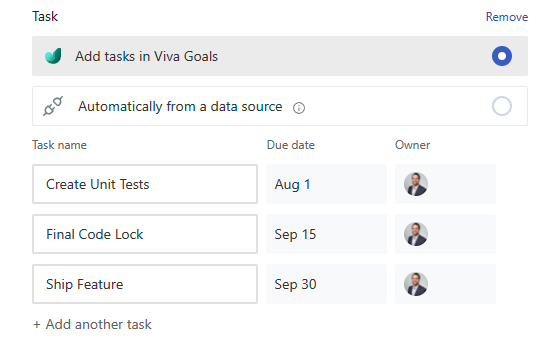Projects/Initiatives in an OKR Framework
Projects/Initiatives can be used under Key Results to track impact and progress. Here are a few tips for creating and managing Projects/Initiatives.
An example of Projects/Initiatives
Projects/Initiatives live under a Key Result, as seen below. Projects/Initiatives can be created and managed by an individual, meaning owned by one person, or created to organize a project for a v-team.
Focus for 12-weeks
We start more than we finish. The book Atomic Habits talks about starting with small habit changes. Then take those small habits and stack them alongside other small habits. This is called habit stacking. In the same way, start your Projects small. Focus on 12-weeks.
As seen in the screenshot above, you could create a single Project under a given Key Result and run that Project for 12-weeks. This would mimic the duration of the Key Result.
This doesn’t mean your Project isn’t complex or detailed. But it does mean that you are forced to think about what can be accomplished in 12-weeks. If helpful you can use Tasks, under Projects, to track some key milestones during that 12-week period.
Finally, if your Project truly runs the entire year, you can break your Project into 12-week phases. The result is still the same. You create a new project every 12-weeks to tackle what lies ahead.
Don’t add up
Projects do not need to accrue to the Key Result measurements. For example, see the screenshot below. The Projects below the Key Results do not need to add up to the overall Key Result. Projects can help a team, roughly, outline areas of individual and v-team focus and impact. This doesn’t mean the OKR owner can’t ask for clarification or, in fact, ask that Projects equate. This is a preference not a requirement.
Make them measurable
Projects benefit from measurement, just like Key Results. Try writing your Projects in such a way that the measurement of impact and/or success is clear. e.g., 10 Features identified and tested with users.
Transient and terse
Given Projects are only 12-weeks in duration they will feel more transient. Yes - you can continue the work, but the work of a Project will differ every 12-weeks. Given Projects are transient, they should not be overly detailed. Fight for brevity. Remember, we only have 12-weeks. Let’s spend our 12-weeks working on the Project instead of working ON the Project.
Use all 4 OKR Superpowers
Projects observe all 4 OKR Superpowers — Focus, Alignment, Tracking, and Stretching.
Focus
Projects must be focused as we discussed above. Projects are focused on the next 12-weeks. Which means we must say “no” to scope creep. If we end up delivering the Project earlier than expected and decide to tack on additional features, great. But, at all costs, we must deliver on the stated Project. Stay focused!
Alignment
Projects must be aligned. It doesn’t help anyone to run a Project that doesn’t align to the team’s Key Results. Ideally, lack of alignment will be called out by the OKR owner before the Project even gets started. If you are not sure, by clear and kind. Ask, “Does this Project help impact our Key Result?”
Tracking
Projects must be tracked. Are we hitting our milestones? Are we on track to deliver? Depending on your OKR tool, Projects should have Tasks. Creating Tasks that deliver every 4-weeks can be a great way to track progress.
Stretching
Finally, Projects can be created in such a way that it is a stretch. If a Project exceeds the individual or v-team’s current abilities, it is a stretch.





